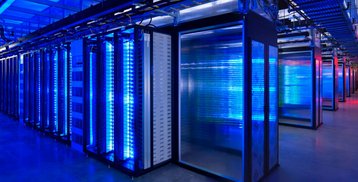Data centers use a lot of electricity, with kilowatt hours ranging in the billions. This energy usage is expected to increase to roughly 140 billion kilowatt-hours annually by 2020, which would cost American businesses $13 billion in electric bills and emit 150 million metric tons of carbon pollution. From this large amount of energy use, lighting can account for up to five percent of energy costs.
While it may seem like such a small amount, it is also one of the easiest areas for a data center to boost energy efficiency. Simultaneously, the benefits go far beyond simply saving you energy, allowing for additional savings with maintenance, and establishing a safer, more efficient work environment for your staff and technologies. When choosing between existing fluorescents and updating to LEDs, here are a few factors to consider:
It might be a small amount, but energy savings are huge
In most data centers, existing fluorescents represent a waste of energy, time and resources, particularly with new advancements in LED technologies rendering them obsolete. A single, complete LED retrofit of existing fluorescent lighting has the ability to reduce a facility’s lighting energy use by 40 to 60 percent, on average, and in some cases has reduced energy use by over 65 percent, as was the case with a recent project from global leader in data center infrastructure solutions, Telehouse America. Since many of these facilities require continual lighting for the safety of the staff, selecting a solution that significantly minimizes lighting use can help save on overall energy costs.
Longevity means fewer maintenance trips
Savings from LED lighting technologies goes far beyond just energy costs. Lights burn out, light output - known as lumen maintenance - decreases over time, and average wear and tear eventually degrades lighting quality. Building operations and maintenance staff are required to take time away from their other responsibilities to replace these lighting technologies, ensuring data centers remain safe, and fully operational.
LEDs are built to last on a number of different levels, from the general construction and materials used to preserve the lighting quality and longevity. Compared to fluorescents which feature delicate glass tubes, most LEDs are created from extremely durable plastics. The use of plastic minimizes the risks associated with breakages and it also provides a 100 percent recyclable solution that does not contain mercury or require a specialized recycling process - giving staff a safe and sustainable lighting option that often lasts for over a decade.
Lifespan and quality consistency are also important, as most data center managers expect a certain light output for a pre-specified amount of time. LEDs can offer a lifespan of up to 100,000 hours, nearly five times that of fluorescent technologies. That could mean up to four additional lighting changes or maintenance operations for staff using fluorescents, if your lighting technologies maintain the same output for the full 20,000 hours. This is another issue, as many fluorescents start to lose their quality after only a quarter of their lifespan, and overall lose about thirty percent of their lumen maintenance. LEDs on the other hand feature 92 percent lumen maintenance, meaning only eight percent of the quality is lost over time, giving maintenance staff a longer lasting lighting solution.
Cutting cooling costs by reducing heat output
Lighting may be only a small portion of energy use within data centers, but it can have a significant impact on minimizing costs and energy used for one of the larger energy drains within these facilities - cooling. In terms of overall energy consumption within a typical data center, HVAC trails slightly behind equipment, accounting for approximately 25-40 percent of energy use. This presents a significant cost saving opportunity for data centers who choose to switch to LEDs. Fluorescents, on average, generate about 90 percent more heat, measured in BTUs per hour, than LEDs. While we know that cooling is primarily used to offset heat generated by the equipment, HVAC systems also have to counteract heat given off by the lighting, which in many facilities needs to be on constantly for safety purposes. Switching to LEDs can help to reduce the amount of heat generated by the facility’s lighting, meaning less energy, and more savings, in order to maintain the required temperature
While lighting itself may only be a small fraction of energy use, its impact and cost savings go far beyond lighting costs. Optimizing time, money and maintenance efforts, LEDs can offer data centers a simple solution that in turn, can help you and your staff be as efficient as possible.
Ron Young is president of Tri-State LED, a division of Revolution Lighting Technologies


